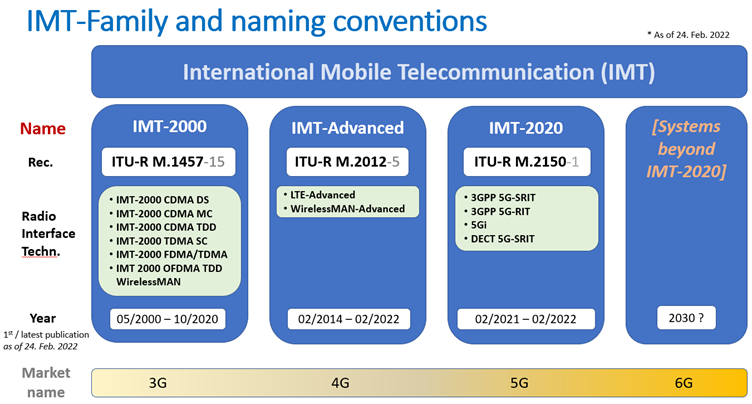
An inside look at mobile broadband standards development
By ITU News
ITU News caught up with Uwe Lowenstein, Counsellor for ITU-R Study Group 5 (Terrestrial Service), to learn more about standards development for international mobile telecommunications.
What does IMT stand for?
International mobile telecommunications – or IMT – is a generic term used in the International Telecommunication Union (ITU) and the radiocommunication and standardization communities to designate broadband mobile systems.
Think of it as the global platform upon which industry and government stakeholders, working primarily through the ITU Radiocommunication Sector (ITU-R), are building successive generations of mobile broadband connectivity.
IMT encompasses three key sets of mobile standards defined and developed by ITU, namely: IMT-2000, specifying third-generation, or “3G” mobile telecom standards; IMT-Advanced, providing for the all-Internet based mobile broadband protocols known as “4G”; and IMT-2020, which broadly encompasses today’s “5G” mobile networks and services.

Are we talking about specific technologies here?
IMT standards are not descriptors for specific technologies, but rather technical specifications for high-speed mobile broadband services.
These standards define which technical parameters a technology would be expected to provide in a corresponding timeframe – such as peak data rate, latency, or spectrum efficiency, for example.
After the ITU-defined evaluation process, ITU develops and adopts global standards for each IMT system and its services and capabilities. When applied worldwide, these enable the harmonization and implementation of mobile broadband networks – 3G, 4G and now 5G – throughout the world.
How are 5G standards evaluated?
The procedure, the methodology, and the technical, spectrum and service criteria for evaluating candidate IMT-2020 radio interface technologies (RITs), which have undergone several tests simulating stringent radio operating environments throughout the world.
The evaluation procedure is designed to ensure a fair and equitable assessment of the overall performance of candidate RITs or sets of RITs – known as SRITs – on a purely technical basis.
The IMT-2020 ‘process’ is still ongoing. Tell us more about that process and its current status.
Standards development for the fifth generation (5G) of mobile broadband, encapsulated in IMT-2020, concluded in February 2021. The requirements for 5G standards were agreed in close collaboration with the telecommunication industry.
As a result, we have seen more than 200 commercial 5G launches across the world and more than 1,200 announced 5G devices, 870 of which are now commercially available.
Initially, in November 2020, three technologies were approved as meeting IMT-2020 specifications:
Two of those, provided by the Third Generation Partnership Project (3GPP), represent the standalone (SA) 3GPP 5G-RIT and non-standalone (NSA) 3GPP 5G-SRIT 5G deployment models, of which the 5G-SA has a completely new radio access network (RAN) and core architecture, without the necessity of an underlying 4G network.
5Gi provided by Telecommunications Standards Development Society India (TSDSI) is an updated version of 3GPP 5G-RIT, designed mainly to improve rural coverage.
In February 2022, a fourth technology called DECT 5G-SRIT was assessed as meeting the standard. Due to the non-cellular and autonomous, decentralized technology, it supports a range of use-cases, from wireless telephony and audio streaming to industrial Internet of Things (IoT) applications, particularly in smart cities. DECT 5G-SRIT was provided jointly by the European Telecommunications Standards Institute (ETSI) and the DECT Forum.
So IMT-2020 and 5G are related, but not exactly equivalent terms.
That’s right. ITU does not have a definition for 3G, 4G or 5G and does not hold a position on how a given technology is labelled for marketing purposes.
But the technologies and services covered by IMT-2000 have been widely deployed for two decades and are commonly referred to as “3G”.
The term “4G” remains undefined, but it is being applied by some operators to the forerunners of IMT-Advanced technologies, such as LTE (Long-Term Evolution) telecommunication, HSPA+ (Evolved High-Speed Packet Access), and WiMAX wireless broadband, along with other evolved 3G technologies, which provide a substantial level of improvement in performance and capabilities with respect to the initial 3G systems.
Similarly, the term “5G” remains undefined. However, the service requirements and system characteristics developed by various standardization organizations for 5G correspond to the key characteristics that ITU has specified for IMT-2020 as the next step in mobile broadband wireless communications.
Have specific spectrum bands been identified for IMT-2020?
Successive World Radiocommunication Conferences have identified specific frequency bands for the deployment of IMT systems in general. You can find these in the Radio Regulations, the binding international treaty that governs the use of radio-frequency spectrum.
This identification does not preclude the use of specific bands for any application for which they are allocated. Nor does it establish priority in the Radio Regulations for 5G or other mobile telecom services over other uses.
Each ITU Member State determines which bands will be made available for IMT in their country depending on national or regional requirements.
Many of these frequency bands are currently used for 3G and 4G or have been earmarked for 5G. The last World Radiocommunication Conference, WRC-19, identified five additional frequency bands for IMT between 24.25 gigahertz (GHz) and 71 GHz.
Will the upcoming World Radiocommunication Conference in 2023 decide on which frequency bands could be used for IMT implementation?
ITU and its Radio Regulations cover the globe in three broad regions for the purposes of frequency allocation and managing the world’s radio spectrum.
The following bands are being studied with a view to an IMT identification:
- 3 600–3 800 megahertz (MHz) and 3 300-3 400 MHz across Region 2, spanning the Americas and the eastern Pacific;
- 3,300–3,400 MHz across Region 1, spanning Africa, Europe, and central and western parts of Asia;
- 7,025–7,125 MHz globally;
- 6,425–7,025 MHz across Region 1;
- 10.0–10.5 GHz across Region 2.
The results of the studies will be submitted for decision at WRC-23.
The IMT process for “Systems beyond IMT-2020” has already begun. What can we expect to happen this year?
The framework and overall objectives are currently under study for the future development of IMT for 2030 and beyond.
This year we can expect a document that overviews future mobile technology trends and other technical aspects needed to inform the development of the next set of standards. These will effectively support what may be referred to as the sixth generation of mobile broadband.
The report contents are still under discussion, but we are seeing some interesting contributions on future technologies expected to drive IMT design. We expect its finalization in June 2022 with approval by early 2023. So, stay tuned!
